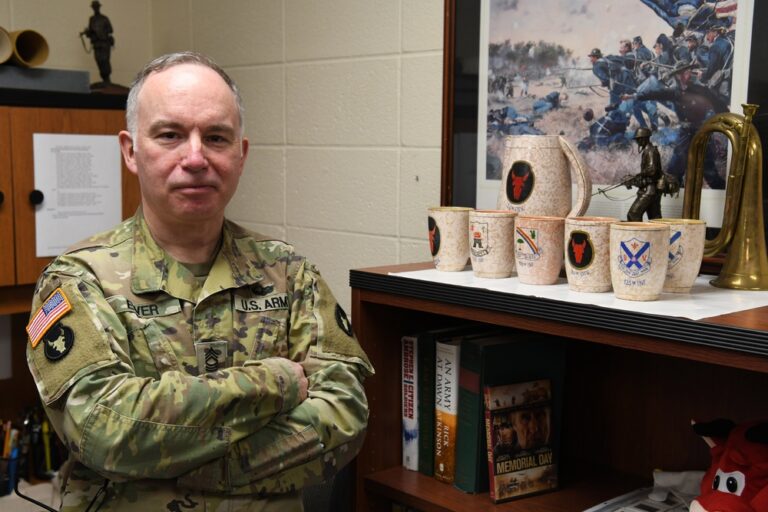March 3, 2021 (CAMP RIPLEY, Minn.) – Throughout the year, we Americans celebrate the rich melting pot of cultures and peoples, taking time to share the accomplishments of our diversities by recognizing several different months by focusing on specific groups.
These groups, often despite extreme hardship, helped shape our country. Their sacrifice as pioneers as well as their triumph as victims showed us the strengths and weaknesses of our society for what it was and for what it could be.
Irish-American Heritage Month is observed in March by proclamation of the President and Congress of the United States to honor the achievements and contributions of Irish immigrants and their descendants living in the United States. It was first celebrated in 1991 and every year in March, the Irish Taoiseach (Prime Minister) visits the United States to mark St. Patrick’s Day. A shamrock ceremony takes place in the morning at the White House where a crystal bowl containing shamrocks is presented to the president in the Oval Office. The claim to the world’s first St. Patrick’s Day parade comes from New York, where it took place on March 17, 1762, celebrating “all things Irish” and featuring Irish soldiers serving in the British Army who protected the colonies during the French and Indian War.
Although many Americans share some part of Ireland running through their veins, acceptance or interest in publicly displaying “green pride” has been an uphill battle from the start in our country. In many settled areas of our rapidly growing country, the blood of the immigrant population, regardless of its origin, was not as American as that of current residents and had to be shed on the battlefields for more than a century to prove their loyalty and patriotism.
In the mid-19th century, the United States experienced an influx of immigration from Ireland. The former British territory was in the grip of a famine, and with limited options for survival, many of the oppressed and poverty-stricken population left their homeland for greener pastures.
“Many became farmers, servants, miners, factory workers, and laborers who fed our nation, kept our homes, and built our industry and infrastructure. They became the soldiers who won American independence, died to preserve our Union, and have fought in every battle since to defend America and its values,” as stated in the 2021 Presidential Proclamation.
Of the more than 3,500 Medals of Honor awarded since March 1863, approximately 2,021 have been awarded to Irish-American recipients, more than double the number awarded to any other ethnic group.
Soldiers like Master Sgt. Dan Ewer is proud of his Irish roots. Currently serving as the 46Z Public Affairs Chief and State Historian with the Minnesota National Guard, Master Sgt. Ewer takes everything he can from his inheritance. Celebrate the positives and learn from the negatives.
“My ethnic heritage is important to me. I’m almost a full-blooded Scots-Irish. Personally, I celebrate both Protestant and Catholic origins. I love the traditional Irish language, music, food, drink, art and literature. I find Irish history both passionate, tragic and ancient. Centuries of Irish heritage inform my past-based identity and provide context for my future,” added Ewer.
Like many soldiers, his priorities changed over the years, but initially Ewer joined the military for the skills he would learn, his experience and the GI Bill. Beginning his military career with the famed 101st Airborne Division in 1984, Ewer found the Army represented a cultural change from his hometown of Anoka, Minnesota.
“Of course I was proud to serve, like my father in World War II, but as a young man I was more self-centered. After the military, I tried life as a civilian, but I missed the camaraderie and being part of something bigger than myself,” he said.
In just a few months, Ewer joined the Reserves, then the Guard, where he has proudly served for the past three decades. During his service, Ewer found the parallel path of military tradition and historic preservation. “The Guard is a respected organization in the community. I am honored to play a unique role that preserves the heritage of this important organization.
Irish-American Heritage Month has never received special attention in the military and is relatively new as a national focus. “Like many other ethnic minorities, I celebrate my heritage all year round and I don’t need a special month. Irish-Americans no longer suffer from racism like African-Americans and other racial minorities, but each upholding ethics is important to its member’s self-image and to demonstrating the value the organization places on inclusion.
“An organization gains strength through a diversity of skills and talents. Inclusion and utilization of all perspectives is necessary for the military to remain relevant, especially the National Guard which directly serves its local communities.
“Irish American Heritage Month events are an opportunity to share the culture I celebrate all year with the rest of the world. I think it’s important to celebrate the diversity represented by each ethnic minority,” Ewer said.
The Céad Míle Fáilte (one hundred thousand welcome) attitude of the Irish considers that everyone is Irish on St. Patrick’s Day. May all ethnicities be celebrated with such inclusion by its members and by the general public!
As with many cultures that have blended and passed on their art, music, language, and heritage to American society, we owe our gratitude to the Irish-American servicemen, storytellers, and entrepreneurs who persevered to develop America as a land of opportunities. Our continued celebration of our diversities can only lead to our overall success as a people and as a nation.
| Date taken: | 17.03.2021 |
| Date posted: | 03/17/2021 1:09 p.m. |
| Story ID: | 391615 |
| Location: | WE |
| Web Views: | 261 |
| Downloads: | 1 |
PUBLIC DOMAIN

This work, Celebrating Irish-American Heritage Monthby Anthony Houseyidentified by DVIDmust comply with the restrictions indicated on https://www.dvidshub.net/about/copyright.


